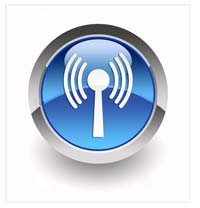The Network
 År 1970 utvecklade Norman Abramson, professor vid universitetet i Hawaii, världens första nätverk för datorkommunikation, ALOHAnet, med hjälp av billiga amatörradioapparater. I det dubbelriktade stjärnnätet av systemet ingick sju datorer som användes över fyra öar för att kommunicera med en central dator på ön Oahu utan att använda telefonlinjer.
År 1970 utvecklade Norman Abramson, professor vid universitetet i Hawaii, världens första nätverk för datorkommunikation, ALOHAnet, med hjälp av billiga amatörradioapparater. I det dubbelriktade stjärnnätet av systemet ingick sju datorer som användes över fyra öar för att kommunicera med en central dator på ön Oahu utan att använda telefonlinjer.
Den första generationen av trådlösa datamodem utvecklades i början av 1980-talet av radioamatörer, vanligtvis kallat packet radio. De la även till talkommunikation med en överföringshastighet som understiger 9600 bit/s, till ett befintlig radionät, vanligen i två meter  amatörband. Den andra generationens trådlösa modem har utvecklats omedelbart efter FCC annonsering i experimentella banden för icke-militär användning av bandspridningsteknik. Dessa modem hade datahastigheter i storleksordningen hundratals kbit/s. Den tredje generationen av trådlösa modem är kompatibla med befintliga nätverk med datahastigheter på storleksordningen av flera Mbit/s.
amatörband. Den andra generationens trådlösa modem har utvecklats omedelbart efter FCC annonsering i experimentella banden för icke-militär användning av bandspridningsteknik. Dessa modem hade datahastigheter i storleksordningen hundratals kbit/s. Den tredje generationen av trådlösa modem är kompatibla med befintliga nätverk med datahastigheter på storleksordningen av flera Mbit/s.
Koordinaterna ovan tar dig till platsen där du får reda på slutkoordinaterna till gömman.
 In 1970 Norman Abramson, a professor at the University of Hawaii, developed the world’s first computer communication network, ALOHAnet, using low-cost ham-like radios. The bi-directional star topology of the system included seven computers was deployed over four islands to communicate with the central computer on the Oahu Island without using phone lines.
In 1970 Norman Abramson, a professor at the University of Hawaii, developed the world’s first computer communication network, ALOHAnet, using low-cost ham-like radios. The bi-directional star topology of the system included seven computers was deployed over four islands to communicate with the central computer on the Oahu Island without using phone lines.
The first generation of wireless data modems was developed in the early 1980s by amateur radio operators, who commonly referred to this as packet radio. They added a voice band data communication modem, with data rates below 9600-bit/s, to an existing short distance radio system, typically in the two meter amateur band. The second generation of wireless modems was developed immediately after the FCC announcement in the experimental bands for non-military use of the spread spectrum technology. These modems provided data rates on the order of hundreds of kbit/s. The third generation of wireless modem then aimed at compatibility with the existing LANs with data rates on the order of Mbit/s.
The coordinates above will take you to the place where you find out the final coordinates to the cache
|
This is number four in a series of technical caches by RubberDuck and Radiola
|